
When someone becomes interested in old-school, traditional wet shaving they usually start out with a safety razor. But the idea of using a straight razor (or “cut throat” razor) almost always follows. Many beginners are not successful with a straight razor though, partly because they don’t understand the variables involved with purchasing (and using) a straight razor. This is an updated post!
TL;DR: What Is The Best Straight Razor For A Beginner?
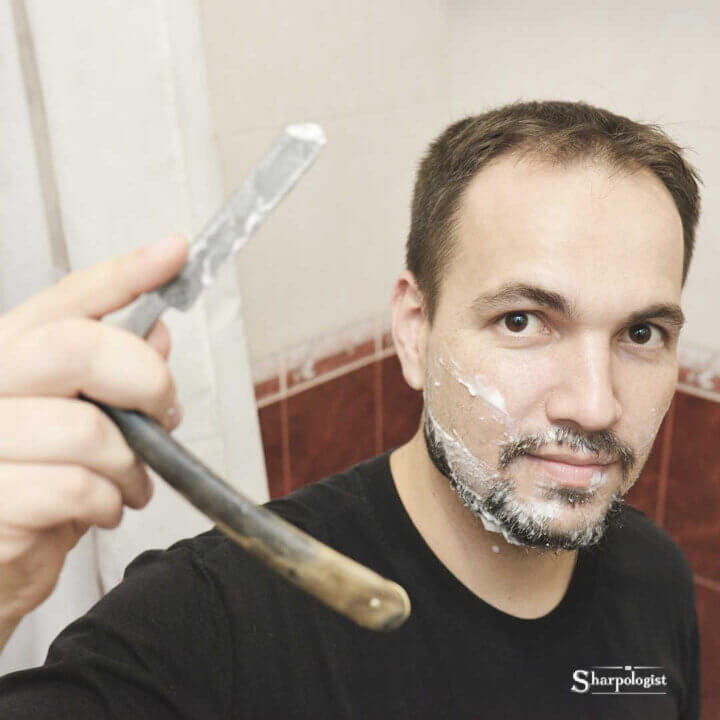
Distilling all the information here into a buying summary, these specifications seem to be the “conventional wisdom” for success with a straight razor for the beginner:
- Blade size: 5/8 or 6/8
- Blade point: rounded
- Blade metallurgy: carbon steel
- Blade grind: full hollow
Brands
Like many other product categories, companies making straight razors come and go. And even during a company’s “lifetime,” quality control can wax and wane. With that caution, here are some general comments about what brands you might want to seek out and what you might want to avoid.
Very broadly, here are a few brands (in alphabetical order) that are among those considered to have the most consistently-positive reputation among enthusiasts:
- Böker
- Dovo
- Ralf Aust
- Revisor
- Thiers Issard
Straight razors manufactured in Pakistan are almost universally criticized and avoided. The metallurgy used is usually inferior, with a temper so soft that a cutting edge just can’t be held.
Avoiding unbranded Chinese-made straight razors may also be a good idea. Gold Dollar brand razors from China are inexpensive but have inconsistent quality control. Some straight razor vendors will buy a quantity of Gold Dollar razors and do their own quality control, selling the ones that can be sharpened for a good price and offering the others as “practice” razors.
Where To Buy
There are a number of wet shaving businesses selling reputable straight razors. Here are a few (in alphabetical order):
- Cut Throat Club
- Fendrihan
- Grown Man Shave (affiliate link. Get 10% off your order with this link!)
- Maggard Razors
- Naked Armor (affiliate link. Get 10% off your order with this link!)
- Razor Emporium
- Shave Nation
- The Razor Company (affiliate link)
- West Coast Shaving (affiliate link)
- Wet Shaving Store (affiliate link)
It is probably best for the beginner to avoid Amazon and eBay unless they can get good advice from an experienced straight razor shaver.
Background
If you do a search engine query about “what is the best straight razor for a beginner?” you will find the top results are recommendations for specific razors, without much discussion about why they’re being recommended. This article is different.
Here I gathered straight edge razor experts and asked them not what specific razor they would recommend, but rather a set of blade specifications to look for. Here are the experts:
Joe Borrelli
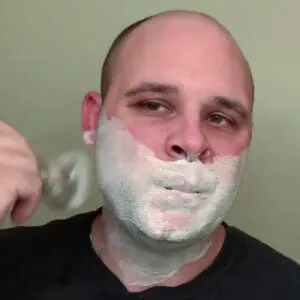
Joe Borrelli is a regular contributor to Sharpologist, and a long-time wet shaving enthusiast and collector. He hosts the Wet Shaving News/Talk Podcast, runs his own self-funded website and operates a YouTube channel to help inform the community of new information involving the wet shaving world. Joe just also published a book on shaving with a straight razor, available on Amazon! (affiliate link) He’s used a straight razor for a number of years.
Brad Maggard

Brad Maggard is the owner/manager of Maggard Razors, a popular wet shaving shopping destination (both online and as “brick and mortar!”). Brad himself is a straight razor user and “honemeister.”
Lynn Abrams
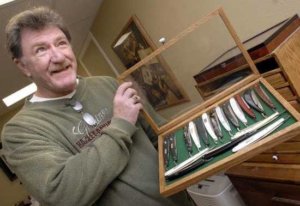
I think of Lynn as “Mr. Straight Razor” and was one of the early adopters (perhaps the earliest adopter!) for using the Internet as a resource to gather like-minded shaving enthusiasts into one spot to share experiences. He’s been shaving with a straight edge razor since the late 1970’s and has mentored many “newbies.”
A Sampling Of Other Expert Straight Edge Razor Users
I also surveyed users of several popular wet shaving forums that specialize in straight razor shaving. While the number of responses (less than 100) may not be statistically relevant, these guys are knowledgeable and passionate about straight razors!
What Is A Straight Razor?
Before continuing let’s focus on the subject: just what is a straight razor?
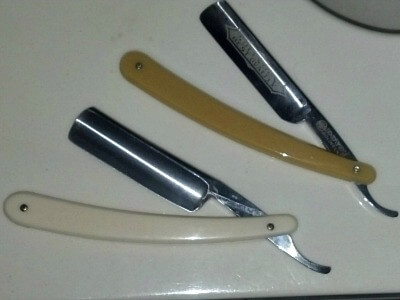
From Wikipedia:
“A straight razor is a razor with a blade that can fold into its handle. They are also called open razors and cut-throat razors….”
“…The design of the straight razor is based on the grind of the blade, the width and length of the blade, the handle, which also affects the balance of the razor, the material of the blade, and the finish and degree of polish of the blade material.”
Traditional straight razors are the original shaving tool, created long before the invention of the safety razor. They are an affordable option (over the long term) for those looking for a quality shave. Straight edge razors are made up of a blade that is not meant to be thrown away and has to be sharpened and cleaned periodically.
What Are The Advantages To Using A Straight Razor?
There are advantages to using a straight razor, including:
- A very close shave when used by a skilled shaver;
- Economical and environmentally friendly in the long term compared to disposable razors (and even safety razors);
- Better quality, more durable blades (when obtained from a reputable source).
What Are The Disadvantages To Using A Straight Razor?
Perhaps the biggest disadvantage to using a straight razor is that it takes time to learn the skills of straight razor shaving with one to get good at it. Some other disadvantages include:
- They need to be sharpened and maintained periodically;
- Straight razors and their accessories are more difficult to find and are more expensive than other methods of shaving in the short term;
- Essentially “zero” safety features. Make a mistake and odds are you will draw blood.
What About A “Shavette” Style Razor?
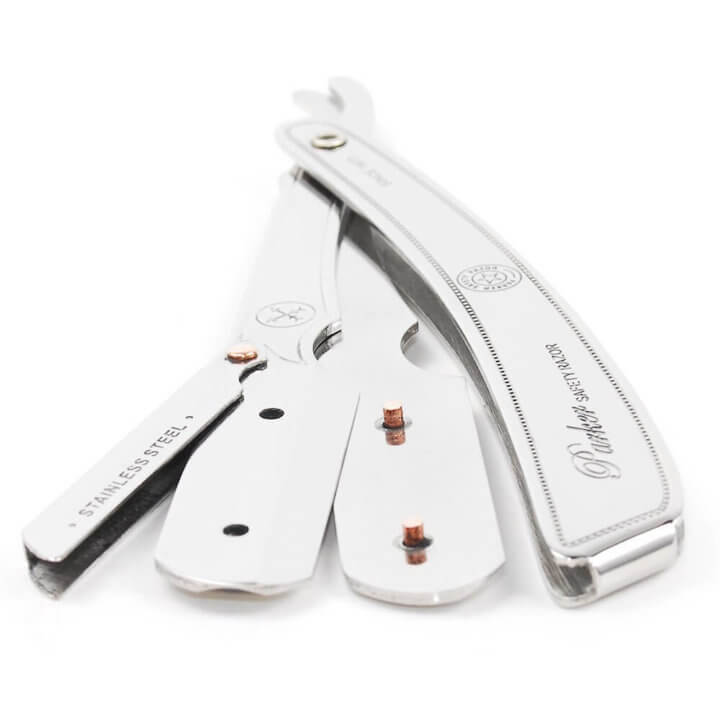
A “shavette” style razor, sometimes called a “barber straight razor” (because some states don’t allow barbers to use a regular straight razor for hygiene reasons), looks similar to a straight razor but uses a replaceable, disposable blade instead of a fixed, permanent blade.
But while a shavette may look like a straight razor, it may not necessarily behave like a straight razor:
- The shavette’s blade length is generally shorter.
- The shavette’s weight and balance are different from a straight razor.
- Shaving with a shavette is subtly different (and sometimes less forgiving!) than shaving with a straight razor due to the thinner, less stable blade.
For these reasons this article will stick with information about a traditional straight razor rather than a shavette. But if you would like to learn more about this particular type of razor read this article.
What About A Japanese-Style “Kamisori” Razor?
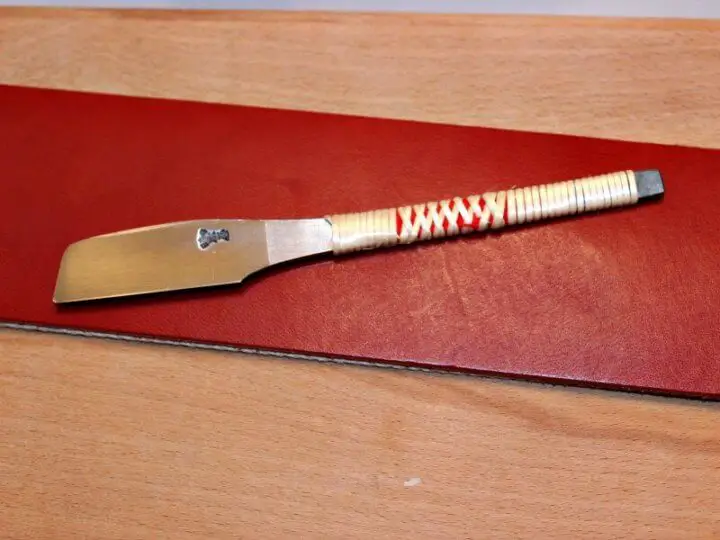
Kamisori are razors made in the traditional Japanese fashion, with a non-folding handle and an asymmetrical blade edge grinding. The Japanese straight razor is also out of the scope of this article but here is a primer about Kamisori.
What Kind Of Person Is Most Likely To Enjoy Shaving With A Straight Razor?
One answer is: anyone who enjoys the idea of a lot more control over their shaving experience.
People who have been introduced to straight razors from other sources, such as barbers or their fathers, are probably more likely to enjoy straight razor shaving too.
Those looking for a “buy it for life” or “eco friendly” shaving experience may be attracted to the straight razor–though some find themselves unwilling (or unable) to stick with it (though they often switch to a safety razor as a “compromise”).
But if you are looking for a more personal and memorable experience, then this is the type of razor that you should go for.
Specifications For The Best Straight Razor For Beginners
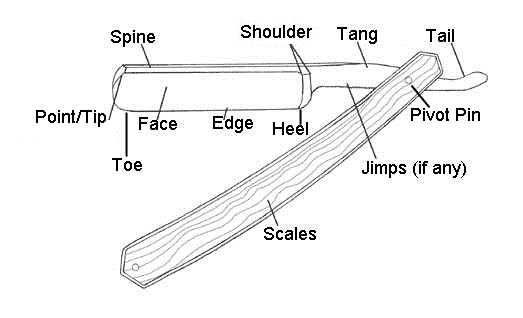
As mentioned earlier, I asked experienced straight razor users what blade specifications they think a beginner should look for. These variables include:
- Blade size or width;
- Blade point;
- Blade metallurgy;
- Blade grind.
If you’re looking for some general information there are a number of good primers on straight razors, such as this one from Grown Man Shave.
Here are the recommendations for each, plus some additional commentary.
Blade Size/Width
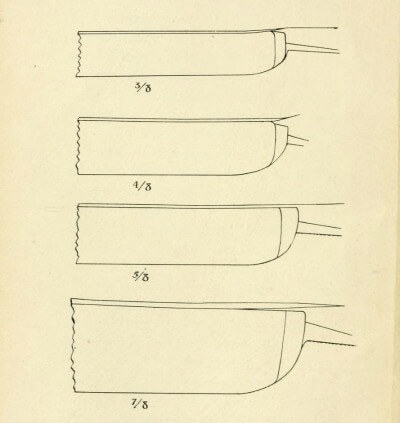
The straight razor blade’s width is usually expressed in one-eighth inch increments from the blade spine to the blade edge. So a “5/8” blade refers to five-eighths of an inch. Smaller blade widths make working in tight areas (like under the nose) easier, while larger widths work well for knocking down heavy beard growth. Here are the group’s suggestions for blade size:
Joe: 5/8
Brad: 5/8 or 6/8. “We try to nudge people toward the larger 6/8 because the vast majority of people generally prefer to use larger blades who get into straight razors.”
Lynn: 5/8 or 6/8
Survey: of the respondents, over 60% suggested 5/8.
Blade Point
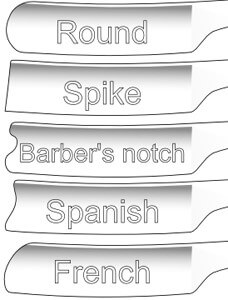
The point is the blade’s far end, which can feature various shapes. The shape of the point is for more carefully shaving hair around hard-to-reach places like ears and nose. Here is a more detailed explanation on blade points from Naked Armor razors.
Joe: rounded point
Brad: “I like to tell people to get what they like the look of. The more you love the look of your straight the more determined you will be to use it, and stick with it through the challenging first few weeks. If you buy a square point, Spanish point, or French point, and find yourself nicking yourself with the tip, you can always take a tiny square of sandpaper and mute the point so that it no longer happens.”
Lynn: either round or square point.
Survey: fully 82% of the respondents suggested a rounded point.
Metallurgy
The two most common metals used in straight razors are carbon steel and stainless steel. Carbon steel is the traditional material of vintage (and many modern) straight razors, generally smoother-feeling on the skin, and easier to sharpen. Stainless steel is less prone to corrosion and the blade edge stays sharper, longer. However keep in mind the “temper” of the metal is variable no matter what the metallurgy is. More on “temper” later in this article.
Joe: “Carbon steel all the way. Holds a good edge and is easiest to hone.”
Brad: “Carbon Steel to anyone buying a straight razor, mostly due to the fact that the shave feels smoother.”
Lynn: “Carbon is probably more readily available in the new stuff in the market today.”
Survey: interestingly, half of the respondents went for carbon steel, while 10% specified stainless steel. Of the other 30% most said “it doesn’t matter” though of those many commented that the choice depended on whether the shaver was going to re-sharpen the razor themself (in that case, go with carbon) or send it out to a “honemeister” to be re-sharpened.
Grind
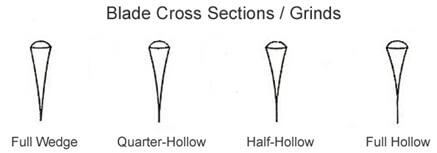
The grind refers to the shape. thickness, and flex of the blade edge. The wedge type is the thickest, least flexible ground type and get progressively thinner until you reach the full-hollow–or even extra hollow–type.
Joe: full hollow.
Brad: full hollow.
Lynn: “…either full or half hollow grind. Both sizes are maneuverable in my opinion for people learning and the full or half hollow are perfect for beginner shavers.”
Survey: of those responding most (44%) suggested full hollow. Another 17% suggested extra hollow, while another 10% swung the opposite way by suggesting half hollow.
Other Things Beginners Should Consider In A Straight Razor
Beyond the major straight edge razor specifications above, there are several other things a beginner should consider when selecting a razor:
Strop
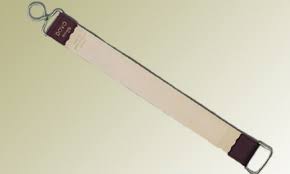
A razor strop is a flexible strip of soft material (often leather or cotton) used to straighten and polish the blade of a straight razor before each shave (but note that “stropping” is not the same as “sharpening”). Check out Joe Borrelli’s article on Strops for a lot more information.
Temper
Related to the metallurgy of the blade, the temper of a razor blade is determined by how long the metal’s edge will stay sharp and keep its edge. The harder the temper, the longer the blade will keep its edge. But softer tempers are easier to sharpen.
Handle (“Scales”)
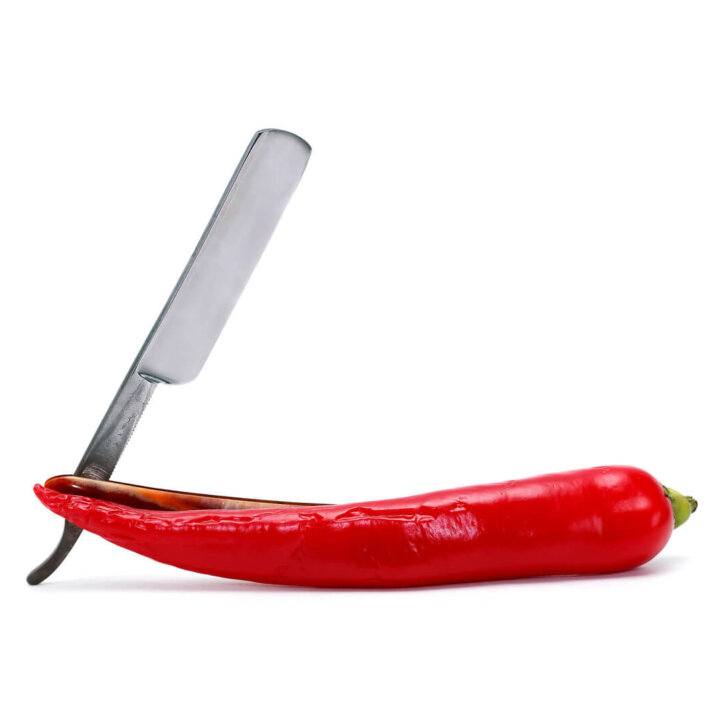
A straight razor’s handle ( or “scales”) can be made from a wide variety of materials, from inexpensive plastics to exotic woods–and everything in between–with no embellishment to intricate designs. While plain, simple scales are certainly less expensive, beautiful scales may give the beginner more inspiration to keep pulling that razor out and using it.
Price
Unfortunately, prices for (good, new) straight razors continue to rise, with inflationary “spikes” that happen when a straight razor happens to get some mass-media attention, such as when the James Bond movie “Skyfall” was released in 2012
For budgeting purposes consider about US $200 the “floor” for buying a new straight razor (and a strop to go with it). Yes, you can probably find a good straight razor kit for less than that price with some judicious shopping around but your expectations should be realistic.
Vintage straight razors can go for less but due to the number of variables involved in purchasing a “used” straight razor it might be best for the beginner to stick with a modern version…or be prepared to do a ton of research before purchasing.
One key detail about price to keep in mind is that a straight razor can be considered a one-time, long-term investment.
Vintage Vs. Modern
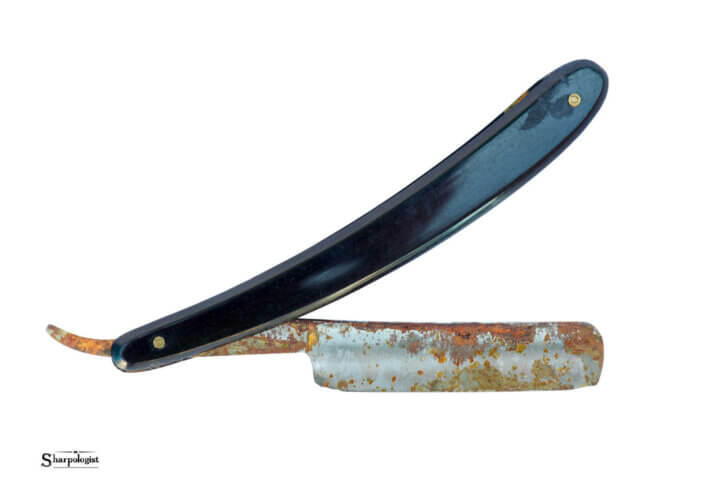
Modern straight razors are created with the latest design and manufacturing technology in mind, and the blade is brand new. Years of experience in designing and crafting razors is something that should not be ignored.
On the other hand a well-maintained vintage straight razor blade can be of the same (or better!) quality as a modern blade if for no other reason than they were made by a skilled craftsman. But a vintage straight razor may require some tender loving care by a professional to restore it to its original condition and may not be the best idea for the beginner.
Initial Sharpening (“Shave Ready”)
It is essential for the straight razor beginner to have a blade that “shave ready.” Most razors delivered from the factory are sharp enough to cut but not necessarily sharp enough to shave. When shopping be sure to look for terms like “shave ready,” “professionally honed,” or similar wording–even if there is an additional cost to do so.
Final Comments From The Survey
I also asked an open-ended question on the straight razor survey about other things a beginner should consider. Here are some selected comments:
At the beginning, there is no way to avoid cuts and nicks. So you have to be willing to deal with this until you acquire enough practice.
I recommend growing a goatee as you get started – the chin is often the hardest, and it’s easier to learn after you’ve practiced of cheek and neck a while.
Has to be perfectly sharp. Learning means mastering the cutting angle.
Focus exclusively on north to south passes and settle for a socially acceptable shave at best for a while. Once you think you have this down find the right size and grind for your beard. I realized I needed bigger heavier and less “singing” blades. It took me a whole year to like the quality of my SR shaves.
MUST have a TRUE SHAVE READY edge
Heavy scales to balance the razor is a must. While plastic or resin might appear to be a good idea, the weight of the blade must be balanced by the scales for a beginner.
A shallow angle about a spine’s width and a feather light touch
Keep it simple, don’t spend a fortune, go with basic good quality, if you don’t take to it you won’t lose too much
When a person brand new to straight razor shaving asks what they should do I usually tell them not to do it.
Nothing super fancy. And stay away from the cheap online stuff!!!!!

I’m a cheap, old, retired redneck (who’s Queen can pinch a penny so hard it gives George a thrill!) and I know you get what you pay for. This is my situation:
I found a really nice looking singing razor at a truck stop along I-40 in New Mexico for $20. It seems to give a “sufficient for my needs” shave. The problem is I can’t find an inexpensive starter kit (I’ve an old leather belt to strop with) that’s just a stone and some jeweler’s rogue. If you know of anyone who sells starter/ replacement supplies…
Thanks.
1. Not buffing much has some logic for speed; but light and relatively fast micro buffing, in the specific following ways is most effective, error free, fast and best allows for new users, and new razors (holders), different blades (and wear), main closeness gap/exposure, settings/plates and different hardware weights, shapes and angles.
And I disagree on DE shaving taking longer (once acclimated) for a really good and error free shave, with it’s proper face cleansing (try a Synth brush for however you shave) as already included. Also adding a tiny amount of no-alcohol lotion in the finish to lock in hydration and not get irritated skin conditions. Acne eliminating!
The specific method and most important is you can trying all devices by simply coming in lightly, always adding just enough pressure, and starting by micro buffing a small stretched area with an angle so flat as it does not yet cut anything, and then simply alter the angle in the most minor amount for each micro buffer until it just starts to shave and so with very light pressure (far unlike cartridges, acne causing friction dragging), THINKING two things: 1. Focus on forcing yourself to STAY light. Else you may need a new blade; that does not beg for dragging, nor the wrong angle. And a sharpness, just enough to not drag on your stubble thickness/age (After your daily face wash. Best prepared by an inexpensive, long lasting synthetic brush, and a quality lather. All for LESS expense and time.) Then 2. With a matched closeness gap for you, by finished feel; but NEVER to the maximum and burn, think HOLD YOUR ANGLE MILD also. So that with the micro buffing those ways, a few fast strokes per area, in that first direction, then you’ll be going from whatever growth of your stubble length and prep, to PROGRESSIVELY closer and closer by STAYING light and angled LESS “aggressively” too. Such that you very first buffing stroke that starts removing stubble does NOT get it all baby smooth (in that direction) and then to next few buffs quickly go to BBS, that way; BUT again NEVER to the LINE of red face burn. So new user must resist go into burn to find it. Creep up on it over the month and let it tell you.
And that way (there are others) then anyone can try DE shaving with *any* DE setup and gain obviously *far* better results than any other face shaving method. Because straights are unnecessarily dangerous; in the general public’s hands. And DE is safe, when simply used at mild angle, in the most aggressive/close shaving, larger gap experienced use holders.
It is human nature to see what happens by pressing in and using a crazy dragging angle to get that last little bit you feel. Don’t. Know that you can get stuborn (BBS felt) spots; by not only re-lathering and only going across in your second pass; but by STAYING light always then going back over a small area will be with FAR less skin irritation, yet maximal and balanced closeness and longer lasting shave. But new users should not even go to the perfect balance their first week. Keep applying this way very patently by shaving, not testing and let it happen over a few days. Your skin does really acclimate to closer shaving and you and your muscle memory gets used to slight changes and good stretching and expression techniques.
If anyone gives that light angle method a mere month, correctly and responsibly (the tool does not move itself) then you will NEVER go back to any cartridge razor. If you get used to these really subtle changes and then go try your best cartridge for you, in it’s best way then you will laugh at why you ever used cartridges. DE is a whole new standard *if* one simply knows it has no one DUMB angle.
And this method will work for finding your best blade and gap, or adjustment level. Of course this includes the sharpest Feather and crazy wide gap closeness always has and always will require this oh so light angle and pressure method. Not really zero pressure; but LOW, with EASY angle.
It’s works because the easiest, mildest angle is enough, going from just glancing to close in the first pass, with a few quick buffs this way. This is done the most extremely light on different areas like your neck and anywhere curling stubble would cause razor bumps that look like regular acne. So use your utmost self control there and some people can’t strictly fell no stubble, baby smooth there. Leave barely felt there AS NEEDED (or a new shaver) and it will stop curing into bumps. By going light and or dialing in your gap and sharpness(etc…) of blade. But since you probably need more close on your chin; it’s best to go your *lightest* angle and push on your neck, leaving barely felt stubble, to stop bumps. Those skin type areas get to that line much easier. And the wonder of DE is its easily handling of your different face and neck areas/zones in lighter this way. Mainly a slight angle change. Now you are driving!
It’s a new adventure for us; but shaving is not new. The is one, good, and long known set of ways to do it with the most effectiveness and avoid any errors at all; but numerous variations and many folks with varying levels of miss placed blame. The challenge is not getting cut up to learn! Never. The challenge is yourself and delayed gratification. The daily technique is the easy part. Not going off on your own way experimenting with razor burn take a real gentleman. And the HUGE difference is only found by those who understand; that some things require at least a small bit of delayed gratification and acclimation and here just a small change. Drive your zone angles right, and stop dragging it to get close. That was because cartridges can’t be customized to YOUR zone variations. Along with all the other helps. And you can also go NOT close, as it can also work best for leaving close stubble, for that look. DE give you easy customization ability (with less expensive, sampler and a adjustable DE razor holder).
I use a modded Futur clone usually; on a crazy jacked-up high aggression gap. And can’t find better than that. To try the no buff methods, I might turn it down. However my way has become extremely fast. Not slower than cartridges. And by get really good enough on my first buffing pass (I could easily stop there for crazy extreme fast shaving), then going all across, it really BBS. And then I go up against the grain directions, like lighter than lightly (not necessary) just so I fell no stubble in any direction! Even against the grain; with the exception of a very slight feel on neck areas that used to get some bumps. Mainly one pass on the neck is enough anyway. Unlike the chin. And I can still hardly tell the difference on my neck, so no one else would even notice the slight feel there, and never see any there anyway. The limit is the limit, per your face zone. Stay a “notch” level over on this side of YOUR error and bumps limit. That is perfect.
Other shaving methods are just fine; but not better overall. Like; I use a simple foil for better on ear. But expensive foil electrics requiring new foil eventually are no where near as close, fast, and will irritate your face health if not just a touch up after close wet shaving. And this idea of shaving in the car with a foil type? That’s not only bad for your face; but you need to stay alive, more than shave while driving. LOL. Body trimmers (rounded) are great; and ladies can greatly benefits from a mild DE holder and usually sharp blade if they will just drive that lighter angle. So, it’s horses for courses and if you know the angle, then nothing at all to fear. In fact those who are fearful need to be careful once they laugh at it, to not then fail to respect the correct DE angle. Minor but critical change in method after forced training on cartridge raking friction. And the required hard rubbing, time consuming, over priced “closer” foils; getting less close. Instead, the$20 single foils where you don’t want close, like on ears! Use DE for closest and custom angle.
Now you can use ANY DE setup, with zero errors.
We used to shave with obsidian knives in my day. Sea shells too😂